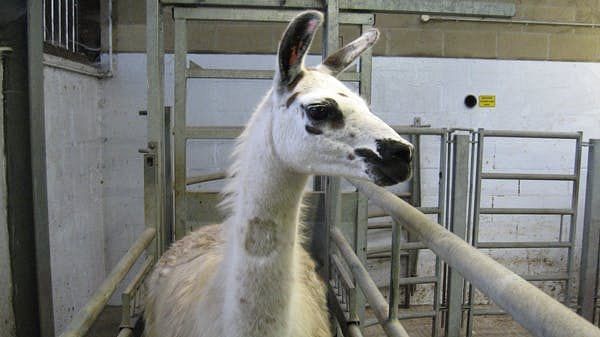The search is on for effective treatments to combat the unprecedented COVID-19 pandemic. Given the lengthy development process for vaccines, one major immediate priority is the development of selective antibodies that can neutralise the SARS-CoV-2 virus responsible for COVID-19. And a particularly exciting new advance is the recent development of “nanobody” technology.
Nanobodies are smaller, more stable types of antibody taken from the immune systems of camelid species – such as llamas, alpacas and camels – that could be more effective at fighting disease. A recent report confirmed that llama nanobodies could neutralise the SARS and MERS viruses and could also be engineered to fight SARS-CoV-2.
Since 2015, the University of Reading has collaborated with several academic and industry partners to generate specialised nanobodies from llamas. We currently keep a herd of 15 llamas at the university, including a recent unexpected arrival in the form of a cria (baby llama), whose mother surprised everyone when her pregnancy was discovered.
The timing of the birth coincided with the leadership contest of the UK Conservative Party in July 2019 and an online poll was launched to name the cria “Boris” or “Jeremy” after the candidates Johnson and Hunt. Jeremy won on this occasion and so baby Jeremy has joined the effort to discover new nanobodies, along with older llamas such as Fifi, who is leading our search for COVID nanobodies.
Our aim is to generate llama nanobodies that bind to proteins in the SARS-CoV-2 virus. These proteins include the “spike” glycoprotein that enables the virus to enter human cells, so these nanobodies could help neutralise it.
We inject the llamas with isolated proteins from the virus and then collect samples of their blood containing nanobodies produced in response by the immune system. Because we are only injecting individual proteins not the entire virus, the animals are not infected. We work with a range of partners, including those at the University of Oxford, Rosalind Franklin Institute and Francis Crick Institute, who extract and test the nanobodies and then reproduce them at a larger scale.
Also read: US govt body now says Covid doesn’t spread as easily from contaminated surfaces or animals
This strategy was recently given a boost by the report that researchers in the US and Belgium had generated llama nanobodies that bind to the spike protein of the SARS-CoV-1 and MERS-CoV coronaviruses behind the SARS and MERS diseases, respectively. What was particularly encouraging was that researchers also demonstrated that engineered nanobodies could neutralise these viruses, but also SARS-CoV-2, in the lab.
They also noted that a conventional antibody (called CR3022), another one that is good at binding to the SARS-CoV-2 spike protein, was unable to neutralise the virus in the same way that the llama nanobody was able to.
Now the hope is that similar llama nanobodies directed specifically against the SARS-CoV-2 version of the spike protein – and potentially against an additional range of viral proteins – may hold the key to combating COVID-19. The next step would be to trial the nanobodies in small animals and then non-human primates.
If this is successful, the authors of the report estimate the first tests of their nanobodies in humans could occur in around one year’s time. Due to their small size, nanobodies could potentially be converted into a fine spray (nebulised) and inhaled – ideal for a respiratory disease such as COVID-19.
Tiny defenders
Llama nanobodies have several potential advantages over conventional antibodies. Each type of antibody is a large compound consisting of “light” and “heavy” chains of molecules, some parts of which are always the same and some parts of which vary between individual antibodies. By contrast, nanobodies consist only of the variable part of heavy chain (VHH).
The VHH region is the “business” part of the molecule, responsible for binding to whatever invader it was created to fight. This means nanobodies can have similar neutralising function to their larger antibody relatives without the extra baggage that other chains add. As a result, nanobodies may be able to access targets that conventional antibodies cannot reach and better avoid detection by the virus. Nanobodies are also more stable in response to heat or chemical attack.
Nanobodies can be produced, stored and even stockpiled as needed. Their properties mean they can be used to bind to and stabilise protein molecules, such as those that may cause disease in the body. The first nanobody drug, caplacizumab, was approved in 2018 and binds to a protein present in human blood to prevent a rare blood clotting disease.
There are also other ways in which a nanobody used against a coronavirus protein could be useful. If a nanobody can bind to a viral protein then this could allow gathering of detailed information about the structure of the protein and how it is presented within the virus.
This could help in the development of new drugs that may treat the infection. Llama nanobodies might also be used to develop much-needed, efficient and rapid diagnostic tests.
Because our work involves animals, it’s important to note that the University of Reading is a signatory to the Concordat on Openness on Animal Research in the UK. In 2019, the university won an Openness Award for its llama research social media campaign. The university is also committed to the principles of “the 3Rs”, working to replace, reduce and refine procedures on animals.![]()
Gary Stephens, Professor of Pharmacology, University of Reading
This article is republished from The Conversation under a Creative Commons license. Read the original article.
Also read: What we don’t know about coronavirus origins might kill us



